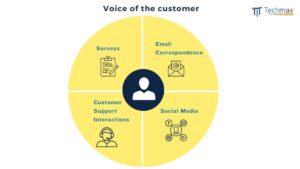In an era where customer expectations are higher than ever, it has become a mission-critical endeavor for businesses to understand what their customers truly want and need. Furthermore, the key to gaining these invaluable insights lies in harnessing the power of Voice of Customer (VOC) analytics. In this comprehensive guide, we will explore how VOC analytics can help unlock a treasure trove of customer insights, and we will delve into how to make the most of this invaluable resource.
1. What is Voice of Customer (VOC) analytics?
VOC analytics is a strategic process that involves the systematic collection, thorough analysis, and insightful interpretation of customer feedback and data. Moreover, its primary purpose is to provide businesses with profound insights into the preferences, expectations, and sentiments of their customers. This comprehensive understanding is essential for shaping and optimizing the customer experience. Additionally, VOC analytics encompasses various data sources, including customer comments, survey responses, social media interactions, email correspondence, and more. By analyzing this data, businesses can understand the customer journey, make data-driven decisions, and implement customer-centric improvements. In essence, VOC analytics serves as the key to unraveling the intricate tapestry of customer insights essential for success in today’s competitive business landscape.

2. The Value of VOC Analytics:
Why should businesses care about Voice of Customer (VOC) analytics? The answer lies in the value it brings:
Enhanced Customer Understanding:
VOC analytics enables businesses to delve into their customers’ minds. Furthermore, it goes beyond merely listening to customer voices; it involves genuinely comprehending their thoughts, emotions, and needs. Through the analysis of customer feedback and data, companies gain insights into pain points, desires, and motivations. For example, they can uncover common challenges customers encounter with their products or services, identify specific preferences, and understand the drivers behind purchasing decisions. This profound understanding enables businesses to customize their offerings and strategies to better align with customer expectations.
Data-Driven Decision-Making:
VOC analytics is a goldmine of data-backed insights. It provides businesses with concrete information derived from customer feedback and interactions. This data empowers informed decision-making across various business functions. For example, product development teams can use VOC insights to prioritize feature enhancements or new product launches based on customer demands. Marketing departments can refine their campaigns to resonate better with their target audience. Sales teams can align their pitches with customer preferences. With VOC analytics, decisions are no longer based on hunches or assumptions but on concrete evidence, increasing the likelihood of success.
Improved Customer Satisfaction:
One of the primary goals of VOC analytics is to improve customer satisfaction. By actively listening to customer feedback and taking action based on those insights, businesses can make strategic changes that directly impact the customer experience. For instance, if customers consistently report issues with a product, VOC analytics can pinpoint the specific problems. The business can then make improvements or offer better support to address these issues. This leads to higher customer satisfaction as customers feel heard and see their concerns addressed promptly and effectively.
Competitive Advantage:
In today’s competitive market, standing out from the competition is essential. Businesses that proactively listen to their customers and adapt to their feedback gain a significant advantage. When customers see that a business values their opinions and takes action to enhance their experience, it creates a positive impression. This can lead to increased customer loyalty and advocacy. In contrast, companies that ignore or neglect customer feedback risk losing customers to competitors who are more responsive and customer-centric. VOC analytics can help businesses not only meet but exceed customer expectations, ultimately outshining competitors in the eyes of consumers. It’s a powerful tool for gaining a competitive edge in today’s business landscape.
3. Gathering VOC Data:
The first step in Voice of Customer (VOC) analytics is collecting comprehensive customer data. This data can come from various sources, including:

Surveys:
Surveys are structured questionnaires or forms designed to collect specific feedback from customers. They can cover a wide range of topics, including product satisfaction, service quality, and overall experiences. Surveys provide businesses with quantifiable data, allowing them to measure customer sentiments, preferences, and opinions systematically. They are a proactive way to gather feedback and can be tailored to address specific areas of interest, helping businesses pinpoint strengths and areas for improvement.
Social Media:
Social media platforms like Facebook, Twitter, Instagram, and LinkedIn are hubs of customer interactions. Monitoring these platforms involves keeping an eye on mentions, comments, reviews, and discussions related to your brand or products. Social media provides a wealth of unfiltered and real-time feedback. Customers often share their experiences, both positive and negative, on these platforms. Analyzing social media data allows businesses to understand public sentiment, identify trends, and respond promptly to customer concerns or praises. It’s a valuable source for capturing immediate customer reactions.
Customer Support Interactions:
Every interaction between a customer and your customer support team is an opportunity to gather insights. Analyzing customer service interactions involves reviewing chat logs, call transcripts, and support tickets. These interactions provide a window into the specific challenges customers are facing, their questions, and their overall satisfaction with the support provided. Businesses can identify recurring issues, common pain points, and areas where additional training or resources may be needed for support teams.
Email Correspondence:
Customer emails often contain detailed inquiries, concerns, or requests. Reviewing these emails can uncover valuable insights into customer needs and preferences. Businesses can identify common themes in customer inquiries, specific product or service issues, and recurring requests. Email correspondence also provides a written record of customer interactions, which can be used for reference and analysis. It’s a source of unstructured data that, when systematically reviewed, can reveal patterns and trends in customer communication.
4. Analyzing VOC Data:
Analyzing VOC data is a pivotal stage in the process, where the raw data gathered from various sources begins to transform into actionable insights. It involves a meticulous examination of the collected data, focusing on identifying recurring themes, sentiment trends, and emerging issues. This deep dive into the data allows businesses to unearth valuable patterns and gain a nuanced understanding of customer sentiments and preferences. Tools such as sentiment analysis and text mining prove to be invaluable during this phase, as they can efficiently process large volumes of unstructured data, revealing hidden insights that might otherwise go unnoticed. By systematically analyzing VOC data, businesses can extract meaningful takeaways that serve as the foundation for informed decision-making and strategic actions aimed at enhancing the customer experience.
5. Prioritizing Insights:
Prioritizing insights extracted from VOC analytics is a crucial step that distinguishes valuable information from noise. Not all insights hold the same weight or significance. To maximize the impact of your actions, it’s essential to identify and prioritize those insights that have a substantial influence on customer satisfaction and overall business success. By prioritizing critical insights, you ensure that your resources, efforts, and strategies are concentrated on addressing the most pressing issues and opportunities. This strategic approach streamlines decisions and speeds up impactful improvements in the customer experience. In essence, Prioritization ensures actions align with the goals of delivering exceptional customer satisfaction and achieving sustainable business growth.
6. Taking Action:
Taking action based on insights derived from VOC analytics is the pivotal stage where the true value of this process comes to fruition. It involves translating valuable insights into tangible improvements that directly benefit customers and the business. Whether the insights reveal areas for product enhancement, opportunities to streamline operational processes or ways to elevate customer support, the key is to implement meaningful changes that address identified issues and align with customer expectations. This phase is where businesses demonstrate their commitment to continuous improvement and customer-centricity by actively responding to customer feedback and making tangible enhancements to the customer experience. It’s more than collecting data; it’s using it to drive positive change, enhancing the brand’s reputation and competitiveness.
7. Continuous Improvement:
Continuous improvement is at the heart of the VOC analytics journey, emphasizing that this process is not a one-time initiative but an ongoing commitment to customer excellence. VOC analytics thrives on a cycle of perpetual refinement, where the collection of customer feedback, data analysis, and actionable insights remains a constant practice. To stay ahead in today’s dynamic business landscape, businesses must regularly review and adapt their VOC analytics strategy. This includes monitoring the outcomes and impact of implemented changes and adjustments made based on customer insights. By iterating and evolving in response to evolving customer needs and market dynamics, businesses ensure that they remain agile, responsive, and well-positioned to deliver exceptional experiences. In essence, continuous improvement is the driving force that keeps businesses at the forefront of customer-centric strategies and competitive advantage.
8. Techmax Technologies and Voice of Customer (VOC) analytics:
Techmax Technologies stands as a beacon of expertise and innovation in the realm of VOC analytics. Additionally, we highly value the importance of VOC analytics in shaping customer experiences. Furthermore, we aim to equip businesses with the tools they need to excel in this field. Our state-of-the-art solutions are carefully crafted to enable businesses to seamlessly collect, meticulously analyze, and strategically leverage customer insights. With Techmax Technologies as your partner, you can unlock the full potential of VOC analytics to drive a culture of customer-centric excellence within your organization. Furthermore, we are committed to your success beyond data collection, with a focus on turning data into actionable insights for exceptional customer experiences. Harness our expertise to ensure that your business remains at the forefront of VOC analytics, fully equipped to meet the ever-evolving demands of today’s discerning customers.
In conclusion, Voice of Customer (VOC) analytics stands as the compass guiding businesses through the dynamic seas of customer expectations. This
Techmax Technologies is your trusted ally on this journey, offering cutting-edge solutions to transform VOC data into actionable strategies, fueling a culture of customer-centric excellence. Embrace VOC analytics for sustained success in the dynamic world of customer-centric business.




